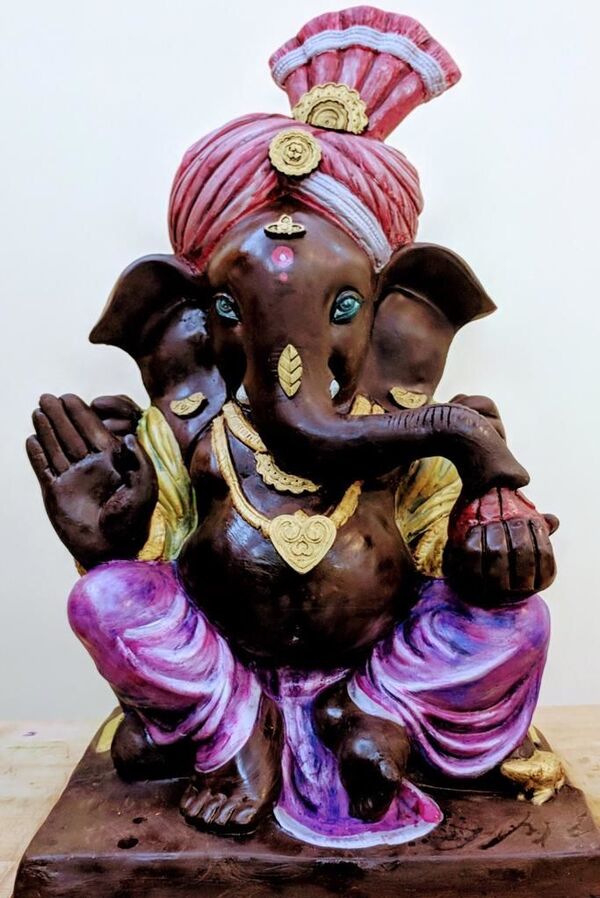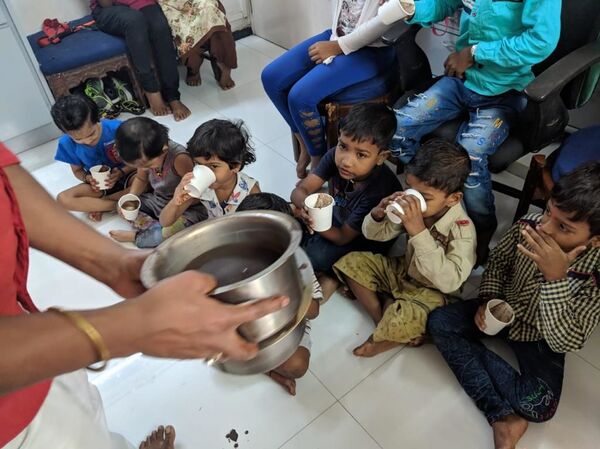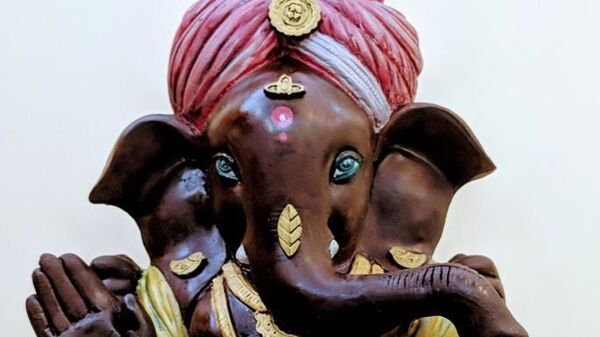The Ganapati festivities, the most anticipated occasion in the Indian state of Maharashtra, invariably culminates with devotees bidding farewell to elephant-headed Lord Ganesha. Also called Ganapati, devotees host Him for 11 days at home.
The worship concludes with the immersion of idols in bodies of water such as holy rivers, sea, lakes and ponds.
In recent years, many people have started having eco-friendly Ganapati idols which easily dissolve in water, reducing the risk of danger to marine life.

Around 10 years ago, Rintu Rathod, a chocolate artist from India’s tinsel town Mumbai, noticed how the city’s beaches get terribly cluttered with the washed-out remains of Ganapati idols after the idols’ immersion.
It gave her the idea of replacing Ganpati idols, which are customarily made of plaster of Paris, with captivating edible idols, made of chocolate.
For such special idols, hard chocolate, weighing between 35-50 kg, is carved to form the elephant-headed Ganapati figures. Edible colours are used to add details to the clothing and ornaments of Lord Ganesha.
Chocolate Ganesha idols in the making! #Rintuarathod #GanpatiBappaMorya #GaneshChaturthi2020 @SputnikInt pic.twitter.com/K92VTM0hDD
— Radhika Parashar (@_RadhikaReports) August 25, 2020
With her chocolate Ganpati idols, Rathod has also put a spin on the final immersion rituals.
“Since these idols are edible, instead of immersing them in water, we let them melt in milk and that chocolate milkshake is distributed to kids from orphanages and slums as Ganapati Bappa’s blessing,” Rathod told Sputnik.
“The concept behind my idea is to worship the deity just as per our traditions, without harming the environment in any way and by making kids happy.”
This is how chocolate sculptor Rinty Rathod gets the visarjan of her chocolate ganpati's done.. later the milkshake is distributed among kids. @SputnikInt pic.twitter.com/6DsytuJnbU
— Radhika Parashar (@_RadhikaReports) August 25, 2020
The “blessed” milkshakes are distributed amongst kids from orphanages, slums and on the streets of Mumbai; for many of them, these little treats are nothing less than a once-in-a-year luxury.

Her innovative idea, however, has been subjected to some criticism by a handful of extremists who believe that since no holy scripture mentions making edible idols of the deities, Rathod’s idea is “questionable” and “disrespectful to Hindus’ religious sentiments”.
Rathod, however, says the worship of Lord Ganesha is not just a ritual, but something that carries emotional resonance.
“Sculptors work for hours on the idols and worshippers offer their heartiest gratitude and love to the deity for 11 days. What happens on the last day? The idols are surrendered to the mercy of water bodies.”
On a grim note, the fanfare of Ganesh festivities end with thousands of broken idols lying on the shores of the Indian Ocean and lakes, with activists crying foul over damage to the ecosystem.
“In Mumbai alone, remains of the Ganpati idols carried back to the beach by the sea waves are scattered around the beaches. That is disrespectful, not feeding the hungry little children,” she contends.
Mumbai beaches to remain cleaner because #GanpatiVisarjan in the sea remains un-allowed amid the pandemic. pic.twitter.com/RPNnIHkeDz
— Radhika Parashar (@_RadhikaReports) August 25, 2020

Over the years, Rathod has also fashioned idols made of sugar-almond mixtures that were later boiled into creamy almond milk. She plans to continue this practice for years to come.
To treat more underprivileged kids across the country, she has also been teaching other people to craft idols out of edible materials.
In recent years, with the subject of the environmental crisis drawing attention from people around the world, idol-worshipping Indians have been exploring ways to keep their cultural values preserved in creative, eco-friendly ways.

From chocolate to clay and mud – artists around India are experimenting with various biodegradable or recyclable materials and non-toxic, eco-friendly materials for the Ganapati idols used in the festival.
गणपती बाप्पा मोरया 🙏💐 pic.twitter.com/PiYF1tckGy
— D Singh Yadav (@Dsingh0964) August 21, 2020
The concept of “tree Ganesha” is also picking up pace in the country. It involves making Ganpati idols out of soft mud, which after the final water immersion ritual becomes ready to nourish potted plants. People usually put saplings of the holy basil plant (Tulsi) in the pots where the mud-idols are dissolved.
Since the annual festival is usually celebrated on a large scale, many devotees have also begun immersing the idols in temporary ponds to avoid doing damage to bodies of water. Take a look.





